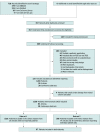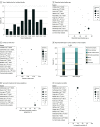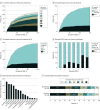Outcomes and Treatment Approaches for Super-Refractory Status Epilepticus: A Systematic Review and Meta-Analysis
- PMID: 37523161
- PMCID: PMC10391362
- DOI: 10.1001/jamaneurol.2023.2407
Outcomes and Treatment Approaches for Super-Refractory Status Epilepticus: A Systematic Review and Meta-Analysis
Abstract
Importance: Super-refractory status epilepticus (SRSE) is defined as status epilepticus (SE) that continues or recurs 24 hours or more after the onset of anesthetic therapy or recurs on the reduction/withdrawal of anesthesia. Current clinical knowledge of the disease and optimal treatment approach is sparse.
Objective: To systematically assess clinical characteristics, causes, outcomes, prognostic factors, and treatment approaches for patients with SRSE.
Design, setting, and participants: In this systematic review and meta-analysis, all studies reporting adult patients (18 years or older) diagnosed with nonanoxic SRSE were considered for inclusion, irrespective of study design. The databases used were MEDLINE, Cochrane Library, EMBASE, and ClinicalTrials.org (database inception through May 5, 2022).
Data extraction and synthesis: The study complied with the PRISMA guidelines for reporting, data extraction, and data synthesis. Different tools were used to assess risk of bias. All available data were extracted and missing data were neither imputed nor completed by contacting the study authors.
Main outcome and measures: Successful treatment of SRSE, in-hospital mortality, and disability at discharge (estimated modified Rankin Scale).
Results: The study team identified a total of 95 articles and 30 conference abstracts reporting 1200 patients with nonanoxic SRSE (266 individual patients were available for meta-analysis). They had a mean SRSE duration of 36.3 days, mean age of 40.8 years, and equal sex distribution. Patients with SRSE had a distinct pattern of etiologies where acute cerebral events and unknown etiologies accounted for 41.6% and 22.3% of all etiologies, respectively. Reports of SRSE caused by, eg, alcohol, drugs, or tumors were rare. At discharge, only 26.8% had none to slight disability (none, 16 [8.4%]; nonsignificant and slight disability, 35 [18.4%]). In-hospital mortality was 24.1%. Mortality stabilized after long-term treatment (more than 28 days) but with increased rates of seizure cessation and moderate to severe disability. Established prognostic factors, such as age and etiology, were not associated with in-hospital mortality. Reported treatment with ketamine, phenobarbital, other barbiturates, vagus nerve stimulator, and ketogenic diet were not associated with outcome.
Conclusion and relevance: Patients with SRSE are distinct due to their pattern of care (eg, long-term treatment to younger patients without negative prognostic factors and unknown/nonmalignant etiologies) and their natural course of SE. Very long-term treatment was associated with lower mortality and high odds of cessation of SRSE but increased risk of moderate to severe disability.
Conflict of interest statement
Figures



References
LinkOut - more resources
Full Text Sources

